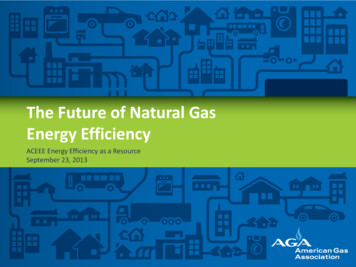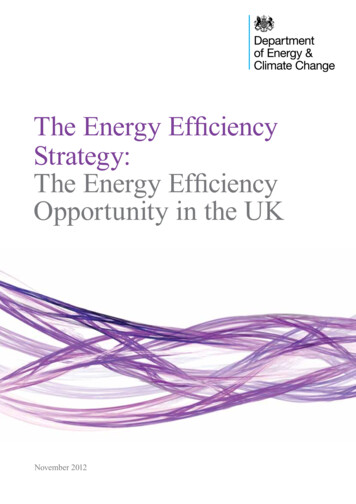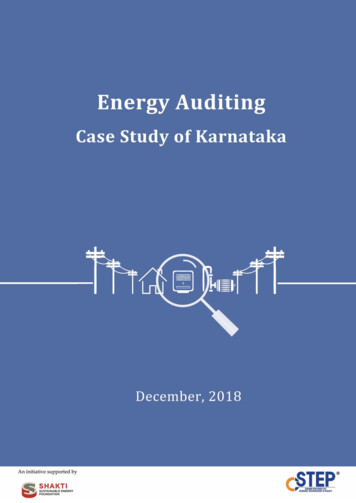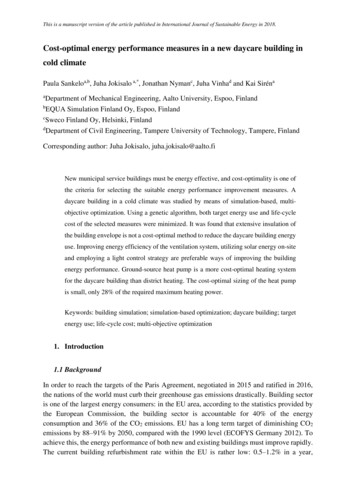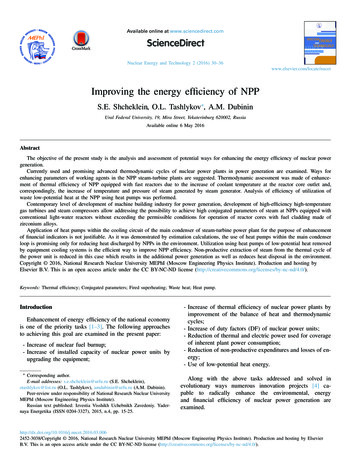
Transcription
Available online at www.sciencedirect.comNuclear Energy and Technology 2 (2016) 30–36www.elsevier.com/locate/nucetImproving the energy efficiency of NPPS.E. Shcheklein, O.L. Tashlykov , A.M. DubininUral Federal University, 19, Mira Street, Yekaterinburg 620002, RussiaAvailable online 6 May 2016AbstractThe objective of the present study is the analysis and assessment of potential ways for enhancing the energy efficiency of nuclear powergeneration.Currently used and promising advanced thermodynamic cycles of nuclear power plants in power generation are examined. Ways forenhancing parameters of working agents in the NPP steam-turbine plants are suggested. Thermodynamic assessment was made of enhancement of thermal efficiency of NPP equipped with fast reactors due to the increase of coolant temperature at the reactor core outlet and,correspondingly, the increase of temperature and pressure of steam generated by steam generator. Analysis of efficiency of utilization ofwaste low-potential heat at the NPP using heat pumps was performed.Contemporary level of development of machine building industry for power generation, development of high-efficiency high-temperaturegas turbines and steam compressors allow addressing the possibility to achieve high conjugated parameters of steam at NPPs equipped withconventional light-water reactors without exceeding the permissible conditions for operation of reactor cores with fuel cladding made ofzirconium alloys.Application of heat pumps within the cooling circuit of the main condenser of steam-turbine power plant for the purpose of enhancementof financial indicators is not justifiable. As it was demonstrated by estimation calculations, the use of heat pumps within the main condenserloop is promising only for reducing heat discharged by NPPs in the environment. Utilization using heat pumps of low-potential heat removedby equipment cooling systems is the efficient way to improve NPP efficiency. Non-productive extraction of steam from the thermal cycle ofthe power unit is reduced in this case which results in the additional power generation as well as reduces heat disposal in the environment.Copyright 2016, National Research Nuclear University MEPhI (Moscow Engineering Physics Institute). Production and hosting byElsevier B.V. This is an open access article under the CC BY-NC-ND license ).Keywords: Thermal efficiency; Conjugated parameters; Fired superheating; Waste heat; Heat pump.IntroductionEnhancement of energy efficiency of the national economyis one of the priority tasks [1–3]. The following approachesto achieving this goal are examined in the present paper:- Increase of nuclear fuel burnup;- Increase of installed capacity of nuclear power units byupgrading the equipment; Corresponding author.E-mail addresses: s.e.shcheklein@urfu.ru (S.E. Shcheklein),otashlykov@list.ru (O.L. Tashlykov), amdubinin@urfu.ru (A.M. Dubinin).Peer-review under responsibility of National Research Nuclear UniversityMEPhI (Moscow Engineering Physics Institute).Russian text published: Izvestia Visshikh Uchebnikh Zavedeniy. Yadernaya Energetika (ISSN 0204-3327), 2015, n.4, pp. 15-25.- Increase of thermal efficiency of nuclear power plants byimprovement of the balance of heat and thermodynamiccycles;- Increase of duty factors (DF) of nuclear power units;- Reduction of thermal and electric power used for coverageof inherent plant power consumption;- Reduction of non-productive expenditures and losses of energy;- Use of low-potential heat energy.Along with the above tasks addressed and solved inevolutionary ways numerous innovation projects [4] capable to radically enhance the environmental, energyand financial efficiency of nuclear power generation .03.0062452-3038/Copyright 2016, National Research Nuclear University MEPhI (Moscow Engineering Physics Institute). Production and hosting by ElsevierB.V. This is an open access article under the CC BY-NC-ND license ).
S.E. Shcheklein et al. / Nuclear Energy and Technology 2 (2016) 30–3631Fig. 1. T-q-diagram of processes of heat transfer in the combined nuclear-thermal cycle of NPP on the basis of VVER-1000 reactor.Fig. 2. General layout of the combined nuclear-thermal NPP: 1 – gas turbine engine; 2 – steam compressor; 3 – steam superheater; 4 – steam turbine operatedon superheated steam; 5 – steam turbine condenser; 6 – condensate pump; 7 – regeneration system; 8 – feed pump.Thermodynamic features of contemporary nuclear powergenerationTechnological cycles of NPPs equipped with water—cooled thermal reactors (LWR) possess the following distinguishing features:- Value of pressure in the primary cooling loop of highpower LWR reactors (15.7 MPa) selected at the presentmoment is associated with restrictions on the temperatureequal to 350 C for fuel cladding made of zirconium alloys. It follows from the above that limiting temperature ofsteam in the secondary cooling loop cannot exceed 315 Cin case of steam overheating. Therefore, selection of zirconium alloy as fuel cladding material and increase of perunit capacity of reactors practically predetermied the following thermodynamic parameters of NPPs equipped withLWRs: pressure in the primary cooling loop equal to about16 MPa, coolant temperature at the reactor outlet equal to320 C–330 C; pressure and temperature of steam in thesecondary cooling loop equal to 6.3 MPa – 7.2 MPa and279 C–285 C, respectively [3].- High capacity of turbine plants is achieved by elevated gasflow rates which influences losses of thermal energy in thecondenser of the steam turbine. Increased non-recoverableheat losses in the low-temperature receiver reduce financial performance of operation of such power units and,therefore, gross thermal efficiency of contemporary nuclearpower plants does not exceed, as a rule, 32–35% [3].Liquid metals allowing removing heat at significant levelsof specific heat release are used as a coolant in fast reactors (FR). At present liquid sodium with temperature at theoutlet from the reactor core amounting to about 550 C (boiling point of sodium is equal to 878 C) is used by practically all power FRs. This allows producing in steam generators superheated steam with elevated parameters (p 13 MPa,t 505 C), enhances thermodynamic efficiency of the NPP
32S.E. Shcheklein et al. / Nuclear Energy and Technology 2 (2016) 30–36Fig. 3. Thermodynamic cycle in the combined nuclear-thermal NPP in T-S-diagram: 1 – economizer section of steam generator of the nuclear facility; 2 –evaporation section of steam generator of the nuclear facility; 3 – compression and heating of steam in steam compressor; 4 – steam superheating in steamsuperheater; 5 – steam expansion in superheated steam-turbine plant; 6 – steam expansion in saturated steam-turbine plant; 7 – steam condensation process;8 – compression process in the pump.and opens perspectives of creation of complexes for nonferrous metallurgy and chemical industry based on nucleartechnologies. FR system with sodium coolant and closed nuclear fuel cycle (NFC) is included in the list of proposednuclear power generation systems of fourth generation possessing enhanced parameters in the field of ensuring sustainable development, competitiveness, safety and reliability, aswell as protection from proliferation of nuclear weapons.Potential of increase of heat supply temperature in theLWR cycleOption of primary steam superheating is examined amongthe above listed approaches to enhancing energy efficiencyof NPPs with LWRS. However, this method for enhancingthe thermal efficiency successfully applied for pressure tubereactors of AMB 100 and AMB 200 types did not have subsequent development primarily because of the necessity to applyin this case high-temperature steels for reactor cores, whichreduces the efficiency of use of uranium fuel. Experience ofapplication of fired superheating at the NPP Indian-Point inthe USA did not produce the expected results because of thethermodynamic inefficiency of use of superheated steam atlow pressure.It is known that maximum thermodynamic efficiency ofsteam-power cycles is achieved by simultaneously increasing the initial temperature and the initial steam pressure. Thehighest efficiency is achieved at the following conjugated parameters of steam (Table 1).Table 1Conjugated steam parameters (final steam humidity in the turbine equal to13%, turbine internal thermal efficiency equal to 0.85).Temperature, C600570540515480450410Pressure, MPa20181412975Present day level of development of machine building forpower generation industry, wide application of steam-gas cycles in thermal power generation, development and manufacturing of high-efficiency high-temperature turbines and steamcompressors allow addressing the possibility of achieving highconjugated parameters of steam by compression and superheating of saturated steam using incinerated gas fuel for NPPsequipped with conventional LWRs without exceeding the permissible conditions for operation of reactor cores with fuelcladding made of zirconium alloys.T-q-diagram of processes of heat transfer in the combined nuclear-thermal cycle of NPP with VVER-1000 reactor(Fig. 2) is presented in Fig. 1.It is clear that the highest thermal power produced by theinstallation is provided from its nuclear part generating saturated steam. Increase of temperature and pressure in thecircuits of the combined NPP is achieved by steam compressor and subsequent superheating steam compression to13 MPa in the steam superheater. Steam compressor driveand superheating of compressed steam are accomplished using gas turbine and steam superheater operated on naturalgas.
S.E. Shcheklein et al. / Nuclear Energy and Technology 2 (2016) 30–3633Table 2Steam parameters and expenditures of energy and gas fuel.Steam parametersPressure, MPaTemperature, CPower, MWSteam generator outletAfter steam compressorAfter gas-fired steam superheater5.91313300450565918528Gas consumption,m3 /hour5431Fig. 4. h-S-diagram of operation of steam-turbine plant (STP) on saturated and superheated compressed steam with intermediate superheating.General layout of the thermodynamic cycle is presented inthe T-S-diagram in Fig. 3 in simplified form (without regeneration system and intermediate superheating.Results of calculation of expenditures of energy and gasfuel for gas turbine drive of the steam compressor andsteam superheating in the steam superheater are provided inTable 2.Intermediate superheating of steam after achieving bysteam of its limiting permissible humidity is widely appliedin operated circuits of saturated steam turbines. Comparisonis given in Fig. 4 of processes of operation of steam-turbineplant (STP) on saturated and overheated compressed steamwith intermediate superheating.The presence of positive effect is evident from the diagramin this case as well. Significant increase of enthalpy of superheated steam penetrating into the turbine as compared withsaturated steam decreases the consumption of steam requiredfor generation of the same power at similar pressure valuesin condensers of turbines.Correlation between the sizes of turbines operated on superheated (K-210-130, K-500-16.7) and saturated (K-220-44,K-500-60, K-500-65) steam is given in Fig. 5 as an example. Let us note that steam turbine K-500-16,7 (live steampressure is indicated in MPa) is intended for operation in thecomposition of power unit of the Kalpakkam NPP in Indiaequipped with fast reactor (PFBR).Analysis of potential of utilization of low-potential heat atNPPNPPs serve as large sources of low-potential heat energy not applicable for industrial use because of the low
34S.E. Shcheklein et al. / Nuclear Energy and Technology 2 (2016) 30–36Fig. 5. Correlation between the sizes of turbines operated on superheated and saturated steam.temperature level. Nevertheless, international experiencedemonstrates the possibility of increase (transformation) ofthe temperature level to the values required for the purposesof heat supply based on the existing status of technology.Different versions of use of heat pumps of steam compression type possessing high values of transformation ratios andallowing ensuring re-distribution of heat flows within the circuits of the steam-turbine plants, optimization of the networkequipment and reduction of discharges of heat energy withcooling water are suggested as of the present moment [5, 6].Operational regimes and parameters of auxiliary systems ofthe reactor and turbine divisions of the NPP equipped withBN-600 reactor were investigated for assessing the possibilityof utilization of waste low-potential heat.Predominant part of all heat wastes discharged by NPPis removed with cooling water from the main condensers ofturbines. The source of low-potential heat in question is characterized by non-uniformity of water temperature in the NPPcooling reservoir during the year and low temperatures ofcooling water during autumn and winter period.Application of heat pump within the NPP technologicalcircuitsThe option when heat can be removed from water at theinlet or outlet of turbine condenser was chosen for assessmentof efficiency of application of heat pump within the steamturbine plant of the NPP. In this case condenser of the heatpump is connected to the regenerative heat exchange systemand replaces the first low-pressure feed heater in the circulation circuit (Fig. 6).With such connection layout the design of the NPP steamturbine plant requires minimum intervention. In the layout inquestion evaporator of the heat pump is mounted on the cooling water intake or offtake channel which allows significantlysimplifying its installation.When heat pump evaporator is connected to cooling waterline at the condenser inlet increase of power produced by theturbine is achieved due to the following two factors [7]:- Steam flow rate increases in the last stages of the turbine because condensate heating in the low-pressure heaterPND-1 is made by the heat pump instead of the extractedsteam;- Possibility appears to increase the heat drop handled on thefinal stages of the turbine due to the reduction of saturationpressure in the condenser as the result of heat removal fromcooling water by the evaporator and reduction of coolingwater temperature.When heat pump evaporator is connected to cooling waterline at the condenser outlet increase of power produced bythe turbine is achieved due to only the first factor. However,since cooling water temperature at the condenser outlet ishigher than at the inlet operation of heat pump becomes moreefficient.When heat pump is connected to cooling water at the condenser inlet both the additionally produced power and theenergy expenditures on the heat pump operation increase. Inthe second case additionally generated power will be lesser,but, at the same time, the energy expenditures on the heatpump compressor will be smaller as well.
S.E. Shcheklein et al. / Nuclear Energy and Technology 2 (2016) 30–3635Fig. 6. General layout of heat pump connection: 1 – heat pump evaporator; 2 – heat pump compressor; 3 – throttling device; 4 – low-pressure feed heater(PND-1); 5 – turbine condenser; 6 - turbine.Fig. 7. Absolute decrease of heat discharges from fast reactor power unit with 600-MW electric power.
36S.E. Shcheklein et al. / Nuclear Energy and Technology 2 (2016) 30–36Data on the average monthly values of water temperaturein the Beloyarskaya NPP cooling reservoir for 2007 were usedin the example presented here. In this case maximum valuesof water temperature amounted to 25.8 C at the condenserinlet and to 34.6 C at the outlet.Reduction of cooling water temperature and saturation parameters in the condenser were calculated for determining additional electric power generated by the power unit in the caseof connection of heat pump to the condenser inlet. Results ofmathematical simulation demonstrate that power required foroperation of heat pump compressor is higher than the electricpower additionally generated by the power unit for the caseof heat pump arrangement both at the cooling water inlet inthe main condenser of the turbine and at the outlet.From the viewpoint of environment protection results ofcalculations allow examining the possibility of use of heatpump within the circuit of the main condenser of the steamturbine plant for reduction of heat discharges by the NPP inthe environment (Fig. 7), which may be of significant importance in certain cases.Application of heat pumps in the heat supply circuitsAnother option of utilization of low-potential heat usingheat pumps is the heating of administrative, amenity and production premises of the NPP and the nearby town. At thepresent moment heat for these purposes is taken from the extracted turbine working steam which reduces the overall NPPpower generation. Use for the above purposes of heat generated by heat pumps with transformation ratio Kt 4 willallow the following:- Reducing heat discharges in the environment;- Excluding (or reducing) steam extraction for the heat supply needs.Analysis demonstrates that this technical solution is feasible from the energy balance perspective [8].ConclusionsEnhancement of energy efficiency of nuclear power plantsis one of the priority tasks faced by the industry which canbe solved by upgrading the equipment of the operated NPPsand by developing innovative NPP projects.Contemporary level of development of machine buildingfor power generation industry, availability of high-efficiencygas turbines and steam compressors allow addressing the possibility of achieving high values of conjugated parameters ofsteam at the NPPs equipped with conventional LWR reactorswithout exceeding the permissible operational conditions forreactor cores with fuel cladding made of zirconium alloys.Application of heat pumps in the cooling loop of maincondenser of the steam-turbine plant for enhancement of financial performance is not feasible. As it was demonstratedby the estimation calculations made in the present study application of heat pumps within the circuit of the main condenser is promising only for the purpose of reduction of heatdischarges from NPPs in the environment.Utilization of low-potential heat removed by cooling systems using heat pumps in the heat supply networks is theefficient method for enhancing the NPP efficiency. In thiscase steam extraction from the thermal circuit of the powerunit is reduced which results in the additional generation ofpower with energy expenditures for its production remainingthe same and heat discharges in the environment are reducedas well.References[1] V.G. Asmolov, Yu.M. Semchenkov, V.A. Sidorenko, in: Proceedings ofInternational Scientific and Technical Conference “Safety, Efficiency andEconomics of Atomic Power Generation, Moscow, 2010, pp. 3–14.[2] L.A. Khomenok, P.A. Kruglikov, Yu.V. Smolkin, K.V. Sokolov, Teploenergetika J. (4) (2012) 10 (in Russian).[3] T.D. Schepetina, Energy: Econ., Eng. Ecol. (12) (2010) 21–29.[4] I.L. Pioro, P.L. Kirillov, S.J. Mokry, Y.K. Gospodinov, in: Proceedings of the International Conference on Advanced Nuclear Power Plants(ICAPP), Anaheim, CA, USA, 2008 June 8-12, Paper #8333, page 10.Special Metals, 2007. Inconel Alloy 718SPF, A Precision Castparts Corp.Company, 16 pages.[5] V.A. Stenin, Sposob raboty teplovoy elektricheskoy stantsii [A method ofoperation of thermal power plant] / Paten RF # 224740 dated 10.03.2005.MPK F01K13/00. No. 2003101028/06 14.01.203 (in Russian).[6] N.N. Efimov, I.A. Lapin, P.A. Malyshev, R.V. Popov, P.N. Radaev,A.V. Cherni, A.A. Lemeshev, G.B. Karataev, A.S. Oschepkov, Teplovayaelektricheskaya stantsiya [Thermal power plant] / Patent RF # 81259dated 23.05.2007. MPK F01K13/00. No. 2007119246/22 Published on10.03.2009 (in Russian).[7] O.L. Tashlykov, E.M. Tolmachev, M.Yu. Semenov, B.G. Sapozhnikov,Mejdunarodnyi nauchnyi jurnal Alternativnaya energetika i ekologiya(Int. Sci. J. Alternative Energy Ecol.) (3) (2012) 16–21 (in Russian).[8] O.L. Tashlykov, I.V. Kovin, V.V. Kokorin, Mejdunarodnyi nauchnyi jurnal Alternativnaya energetika i ekologiya Journal (Int. Sci. J. AlternativeEnergy Ecol.) (3) (2012) 22–25 (in Russian).
thermodynamic inefficiency of use of superheated steam at low pressure. It is known that maximum thermodynamic efficiency of steam-power cycles is achieved by simultaneously increas- ing the initial temperature and the initial steam pressure. The highest efficiency is achieved at the following conjugated pa- rameters of steam (Table 1). Table 1





